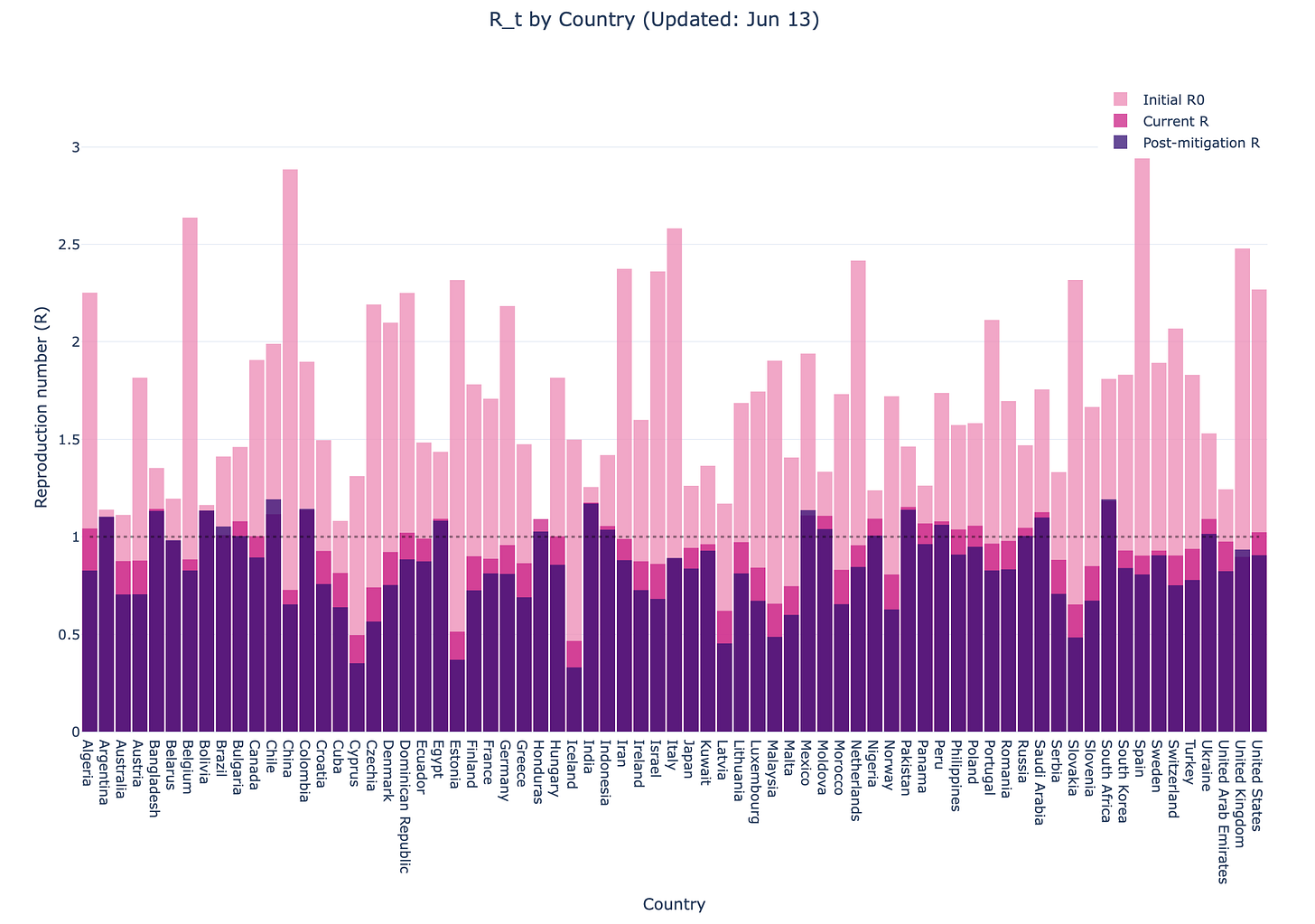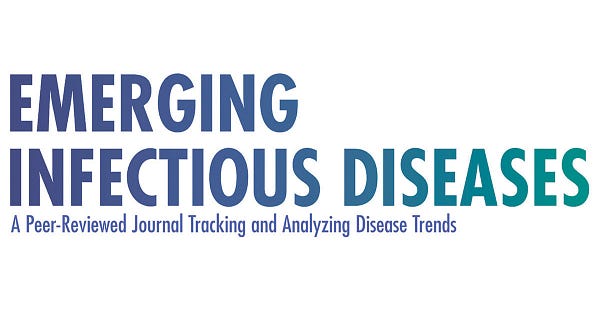🦠 COVID-19 | A sombre outlook
📊 Daily Data Brief: (June 14, 2020, 05:58 GMT) (❗️Previous data: June 12, 2020, 05:33 GMT)
Cumulative case: 7,872,684 (+275,122) cumulative cases
Active cases: 3,397,743 (+66,231) (this is the number of currently infected patients)
Total Deaths: 432,475 (+8,629)
Serious/Critical Cases: 54,107 (+191)
Recovered: 4,042,466 (+200,262)
Source: Worldometers
1) Seven-day rolling average of new deaths (ECDC data).

Showing a chart from the FT today highlighting the worrying situation in Brazil, Mexico, India and Russia and Iran (NEW❗️). Also the FT comparative charts now allow up to 6 countries.

2) Rt estimate per State (US) and per country (NEW❗️). This is a new resource link in the data section from a team which has led accuracy in modelling fatalities in the US for the past few weeks. (Link)


A number of US states are trending poorly while new cases numbers and infectivity rate are creeping up nationally. The US outlook is worrying even before seeing the potential increased spread from the Black Lives Matter protests. China is also reporting its first clusters after a quiet period. The virus methodically continues to find hosts to infect and replicate, wherever and whenever the conditions for doing so allow him to do so.
Kai Kupferschmidt comments on today’s Twitter thread of the day on a study from Japan shedding some light on what could be those conditions public policy and citizens need to pay attention to. This is an area where we will need to continuously learn to refine and improve our policies and behaviour.
Further evidence that the virus might be mutating, and that the D614G mutation might improve its infectivity.
Turning to the policy side, a good post on the requirements for successful evidence-based policy making: it is not about “following the science”. Finally, increasing talk of using monetary policy to direct cash directly to households as opposed to financial assets through large scale quantitative easing.
An interesting article looking on how the pandemic could have catalysed the current global protests. A good analysis of what Big Tech wants from the pandemic and why citizens should worry about its increased cosiness with governments.
Finally, and as always, a great weekly round up by Bob Wachter (Chair of Medicine at UCSF) including an article on how Trump could credibly use current vaccine timeline for his advantage come October.
🇺🇸 Image of the day: This is from the Covid Exit Strategy website tracking trends state by state in the US. Most worrying states: Arizona, Texas, North Carolina, Florida, South Carolina and Alaska.

❗️ Tweets of the day:
🇺🇸 Tweet 1: Some early evidence that situation is worsening in the US



🇨🇳 Tweet 2: First new clusters in China “after weeks of quiet”.


🦠🇯🇵 Thread of the day: Kai Kupferschmidt (Science journalist) comments on the publication of “Clusters of Coronavirus Disease in Communities, Japan, January–April 2020” in Emerging Infectious Diseases journal. (Twitter thread)


These type of studies will prove crucial in helping economies restart while SARS-CoV-2 continues to circulate by informing both public policy and citizen behaviour to help minimise transmission.
🧬 The Scripps Research website posts “Mutated coronavirus shows significant boost in infectivity” on the back of the pre-print published by Scripps Research virologist Hyeryun Choe et al. of: “The D614G mutation in the SARS-CoV-2 spike protein reduces S1 shedding and increases infectivity”.
The pre-print by Choe et al. postulates that:
“A tiny genetic mutation in the SARS coronavirus 2 variant circulating throughout Europe and the United States significantly increases the virus’ ability to infect cells, lab experiments performed at Scripps Research show.”
Some of you might remember the controversy surrounding a previous publication (“Spike mutation pipeline reveals the emergence of a more transmissible form of SARS-CoV-2”) by Bette Korber et al. making a similar claim, and reported in-depth in the previous Corona Daily edition “Science at work”.
The Korber et al. pre-print sparked controversy, in my opinion in great part due to a contentious reporting by the Los Angeles Times. Ed Yong also covered the topic of mutation the next day in an article titled “The Problem With Stories About Dangerous Coronavirus Mutations” (full discussion in Corona Daily here).
In summary, the response to the Korber pre-print and its postulated hypothesis was virulent. One of the contentious point flagged by Yong was that a mutation in Ebola with far more data substantiating its potential increased infectivity later proved to be without merit:
“Two independent teams of scientists showed that during the West African Ebola outbreak, that virus picked up a mutation called A82V, which made it better at infecting lab-grown human cells. Those teams had a stronger case than the Los Alamos team now does for SARS-CoV-2—but they still clarified that they didn’t know whether the mutation influenced the course of the historic outbreak. Sure enough, later work revealed that the A82V mutation doesn’t affect Ebola’s ability to infect actual animals.”
The pre-print by Choe et al. now show increased infectivity of D614G in lab grown cells by demonstrating an increase in functional spike protein on the surface of the virus thereby providing an explanation for better transmissibility.
It is still science at work as the paper is yet to be peer-reviewed and because confirming in the real world what is observed in lab-grown cells will require additional research. It is nonetheless becoming a stronger hypothesis. (Link)
🏛 Ranil Dissanayake writes “Evidence-Based Decision Making During COVID-19: How to Navigate Extreme Uncertainty and Urgency” for the Center for Global Development. (Link)
Dissanayake writes a well constructed piece to dissect the interaction between science, economics and other research areas, and policy makers, ultimately looking at how to improve it going forward for COVID-19 and more generally when faced with uncertainty and urgency to act.
He reminds the reader, that it is up for policy makers to ask the right questions, for them to determine how well researchers are able to answer them at any given time, and for them to decide and foster the multi-disciplinary collaboration needed for optimal policy design. In doing so, Dissanayake further undermines the myth of “following the science”, and puts squarely the responsibility of policy failure where it belongs.
For example in relation to SAGE the UK scientific advisory group he writes:
“The need for speed in policymaking and research generation should be balanced with pursuit of the cognitive diversity and range of viewpoints that broad collaboration brings. It is difficult to look at the UK’s SAGE group of experts without being struck by how uniform its composition is. It is dominated by medical scientists, statisticians, and those with an AI/computing backgrounds. Who offers advice on trade-offs between say, health and education?”
Dissanayake then set out four proposals to improve evidence-based policy making:
“Cognitive diversity in policymaking and open challenge
Regular updating of research
Flexibility and adaptation in policy
Transparency of decision-making”
On the fourth proposal he writes:
“Publishing advice and data as they are received facilitates faster challenge and review, and the possibility of catching and rectifying mistakes earlier. Of the four proposals I make this is perhaps the hardest to square with political incentives, which too often run to obfuscation. It may also be the most important.”
In summary, policy makers should follow the “honesty, transparency and openness” principles followed by scientists to earn the trust of the public.
🏦 Caroline Bentham writes “Direct cash transfers to households: the Bank of England’s response to COVID-19 and the end of orthodoxy” for the LSE Blog. (Link)
At a time when the stock and bond market have held relatively well since the beginning of the year, whilst unemployment has dramatically shot up around the world, this is a very welcome article on whether in times of crisis the large and growing quantitative easing programmes put in place by central banks around the world are adequate policies.
Most central banks have until now refrained from considering the social consequences of their monetary policy as outlined by Bentham in relation to the Bank of England:
“The Bank of England insist it’s not their job to prevent social side-effects of monetary policy- their only job is to control price inflation by stimulating the economy when necessary, and the government needs to implement policies to offset social inequalities caused by central bank policies.”
However, given the impact of the Federal reserve and other central banks on the stock and bond market, it de facto supports the top decile, as shown for the UK in the chart below (included in Bentham article):

While a minority of people in the US worry that the deposit insurance in the US “insures deposits in member banks up to US$250,000 per ownership category”, a recent survey estimates that 58% of Americans have less than US$1,000 of savings.
While some Eurosceptics will have gleefully seen the recent German Court ruling against the European Central Bank (ECB) as cracks in the eurozone, it should maybe be seem as a legitimate and broader concern on the adequacy of quantitative easing. In sum one could easily be a europhile and denounce the ECB flooding the market with credit.
✊🏿 Barry Eichengreen (Professor of Economics at Berkeley) writes “Rage Against the Pandemic” for Project Syndicate. Rather than looking at how the protest following George Floyd death might worsen the pandemic, Eichengreen looks at how the pandemic worsened the rage and the social inequalities in the US, particularly for African Americans.
An intelligent and well referenced analysis, also pointing out that even though the welfare safety net in Europe is stronger, EU leaders should nonetheless assume that similar dynamics could well trigger large scale social unrest there. (Link)
🖥 Franklin Foer writes “What Big Tech Wants Out of the Pandemic” for The Atlantic. (Link)
A thoughtful piece about Big Tech and government, and how both might form alliances which citizens should be weary of. For a start, Big Tech might think that helping government during this crisis will help them stave off the public call for breaking them up:
“But as idealistic companies age, they start to reconsider the principles of their youth. And the major tech firms can no longer plausibly pass as plucky start-ups. An antimonopoly movement, with adherents on both the left and the right, has been slowly rising.”
Foer goes even further arguing that the profits/efficiency drive of Big Tech and the temptation of government to increase surveillance/control might be a bad influence for both:
“As tech and government grow more comfortable with each other, they’ll face the temptation to further indulge their shared worst instincts.”
Whilst it is imperative to continue to be vigilant and ask for transparency from governments in their dealings with Big Tech (and citizens should welcome the recent success of Open Democracy with the UK government with regards to heath data-sharing contacts: “Under pressure, UK government releases NHS COVID data deals with big tech”), one should not fall for Big Tech’s self-serving claim that their AI/data harvesting capacity give them manipulative power at scale as Cory Doctorow rightly argues in a recent article (“How Big Tech Monopolies Distort Our Public Discourse”):
“We should always be skeptical of marketing claims. These aren't peer-reviewed journal articles, they're commercial puffery. The fact that the claims convince marketers to give billions of dollars to Big Tech is no guarantee that the claims are true. After all, powerful decision-makers in business have a long history of believing things that turned out to be false.”
Citizens have a lot more agency and resources than Big Tech claims. Now is the time to use them to make sure the interface between Big Tech and government during this unprecedented crisis is kept in check.
🎬 Video of the day : As always, Bob Wachter (Chair of Medicine at UCSF) Grandstand video and accompanying thread is a great resource to catch up on what happened this past week in the pandemic. The video is a 76 minutes watch and the thread is a 11 minute read. Full of great references.
(Twitter thread)



